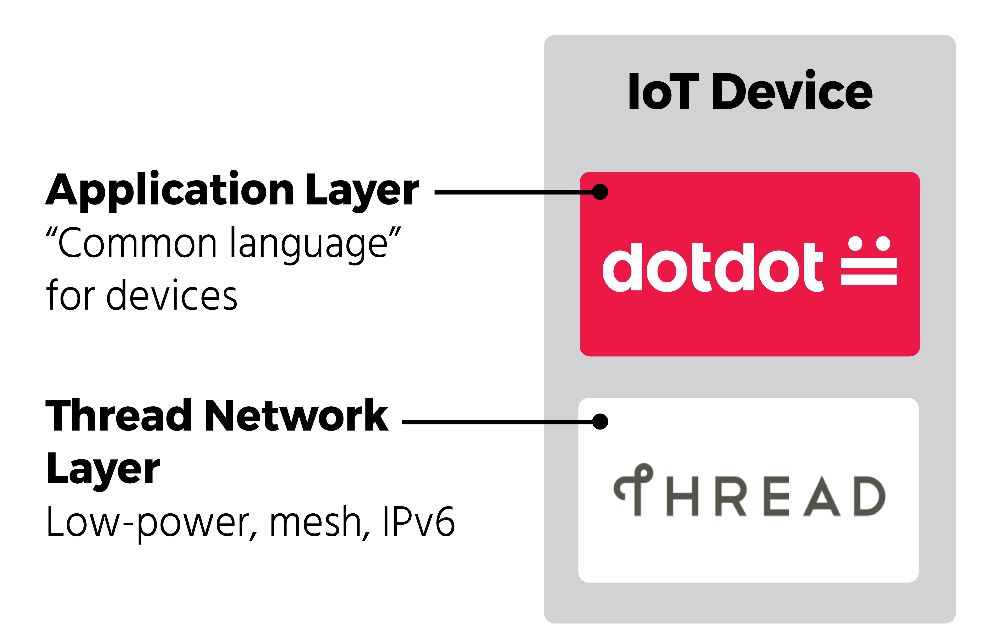
Dotdot : IoT Language
Author: Mr. Chairman EzraHale Silicon Labs Software Systems Engineering Manager and Technical Subcommittee MeshIP Zigbee Alliance
Silicon Labs (Science Technology), an important member of the Zigbee Alliance and the Thread Group, has spared no effort in recent years to develop and optimize dynamic multi-protocol wireless technology, and can quickly promote various wireless technologies to communicate without hindrance. With the Zigbee Alliance and ThreadGroup officially issuing the new Dotdot specification based on the Thread IP network, as the universal standard application language for intelligent devices to communicate on any network, developers can confidently use mature, open, and available IP networks for the first time. The interoperable IoT language will help integrate the fragmented smart connected device industry and open up new markets.
To help engineers more easily understand Dotdot 's basic knowledge and design applications, Mr. Ezra Hale , the software system engineering manager of Silicon Labs and chairman of the Zigbee Alliance Mesh IP Technology Subcommittee , wrote a technical article - "Dotdot : IoT Language " - from a macro perspective. The Dotdot specification and application level are introduced, as well as many advantages brought to the development of IoT devices. Please click “ Read the original †to view the full article.

Silicon Labs Software Systems Engineering Manager and Chairman of the Zigbee Alliance MeshIP Technical Subcommittee Mr. Ezra Hale
The key element of IoT network standards: universal application layerIn 2013, three engineers (one from a protocol stack vendor and two competing door lock manufacturers) sat in a windowless conference room in Boston, where they reached an agreement to build their IoT devices. The door lock designs of the two manufacturers have their own characteristics. They all hope to integrate into the Zigbee ecosystem and communicate products in the same way. This collision of ideas produced some controversial places, but after a few days the engineers reached an agreement, which became the Door Lock Cluster in the Zigbee Cluster Library (ZCL).
At the application layer, Zigbee provides a standardized communication protocol through an entity called a "Cluster". Clusters define what commands the device can send or receive and what data or attributes the device is aware of. The cluster of locks defines all the functions including locking and unlocking time and password lock according to the expected schedule. Therefore, at the absolute top level of the Zigbee protocol stack, the door lock has a very clear and standardized way to communicate with the rest of the Zigbee network and the outside world.
This sounds bland, but it is important that the work done by these engineers has been reproduced hundreds of times in Zigbee. In the past decade, Zigbee member companies have built Zigbee Cluster Library (ZCL) covering a wide range of application functions ranging from lighting to window sensors, from thermostats to smart meters. This is the core of ZCL. When it is ported to other network transmissions, it is the true value that Zigbee brings.
In the Internet of Things, every smart device must understand and use the same language in the application layer. It is expected that smart concentrators will know how to communicate and control with off-the-shelf door locks or thermostats. Without a common application layer, how the network layer performance is really not important. The common application layer is a key element of the IoT network standard requirements. It is the core value of porting the Zigbee cluster library as a common and independent application language. It is also the achievement that Zigbee has named as Dotdot.
The reason for adopting Thread : IP- friendly network layer
The Thread network protocol uses 6LoWPAN, a streamlined form of IPv6. This allows the Thread device to interact directly with other IP devices without going through the gateway as in Zigbee 3.0. The border router on the Thread network acts as a channel from IPv6 data to the cloud and vice versa. Therefore, devices on the Thread network can directly interact with other IP devices.
Reasons for adopting Dotdot : IP- friendly application layer
Dotdot uses the generic, IP-friendly protocol specifications defined by the Internet Engineering Task Force (IETF), such as restricted application layer protocol (CoAP) and concise binary object representation (CBOR). Therefore, the open library can be used to develop applications, greatly speeding up the process of device development.
Joint, higher level securityDotdot over Thread (see Figure 1) requires datagram transport layer security or DTLS. This allows devices on the Thread network to ensure that they not only communicate with trusted devices but also secure their communications. In addition to using DTLS, Dotdot also requires authentication and authorization for use on Constraint Environments (ACEs), commonly referred to as access control. Access control allows the deployment device to specify exactly which resources are available on a device. Even if the thermostat shares a DTLS connection with a door lock, it cannot directly control the lock unless it has the proper access rights.
To date, product developers have had to choose among the following technologies: a) support reliable, local, device-to-device interoperability, but often their products (and their data) have difficulty on third-party gateways, Or b) Connect these products directly to the Internet, but in order to connect devices together in an efficient manner, you have to face the challenges of reliability, interoperability, and user experience.
Dotdot over Thread offers the best of both worlds.
Device to Device CommunicationThe Zigbee Cluster Library is built and optimized for device-to-device communication and battery-powered devices on low-power and lossy networks. This means that the information is compressed into a compact, optimal fit within a single 127-byte 802.15.4 packet. In addition, the message mode is based on minimizing communication between devices and reducing unnecessary 'communications'. And battery-powered devices initiate most of their communication because they cannot be reliably received while sleeping. The development of Dotdot maintains these basic principles and experiences in the ZCL to ensure that it also applies to these low-power and lossy networks while switching to publicly-aware IP-friendly protocols.
Direct networking to the cloudUsing Thread eliminates the gateways that are usually required on a mesh network and it directly understands how to communicate with each device. By using a generic Thread Border Router, it is possible to create a DTLS connection from anywhere on the Internet to a device on a local mesh network and to communicate securely with the device. This allows the "brain" of the IoT system to be in the cloud and communicates directly with devices on the network without worrying about firmware versions on the gateway. The Thread Border Router acts as a channel, so when the composition of the mesh network changes and new devices are added or upgraded, it does not require firmware upgrades. This means that complicated things can be done, such as directly updating the firmware of the device on the mesh network from the cloud on the secure communication channel, which greatly simplifies the management of the mesh network device.
Dotdot to Zigbee CommunicationSince Dotdot is derived from ZCL, using a gateway to convert between the two is simple. This is critical because it means that new Dotdot devices can seamlessly bridge existing Zigbee devices, ensuring smooth user experience and interoperability. This also means that existing Zigbee devices can be bridged to the cloud using Dotdot and IP-friendly protocols, simplifying remote device control and management.
Dotdot certification projectZigbee has certified nearly a decade of application layer functionality (Zigbee Cluster Library). The Zigbee Alliance is also developing an automated test environment for Dotdot. This test environment ensures that Zigbee and its members can authenticate DotDot devices and their application layer functions, and ensure that devices from different vendors can interoperate on the same mesh network. When you choose Dotdot as your application layer for your IoT device, you have the benefits of a reliable, certified project.
Dotdot on other IP networksAlthough the initial focus was Dotdot over Thread, it was relatively simple to extend to other IP networks. Dotdot is based on the IP friendly protocol and IPv6, so usage can be easily extended to Wi-Fi or Ethernet. For Bluetooth transmission technologies that do not essentially support IPv6 or IP protocols, some adaptation is required.
Three Cores Medium Voltage Cable
Middle Voltage Electric Cable
Standard: IEC 60502
Rated Voltage: 3.6/6kV to 26/35kV
Armour: Aluminum Wire Armored, Steel Tape Armored, Steel Wire Armored,
Certificates: Third party test reports
Applications: Those Medium Voltage Power Cables used for power networks,industrial plants, underground and in cable ducting.
Three Cores Medium Voltage Cable,Types Of Medium Voltage Cables,Three Cores Medium Voltage Cable Termination Kit,Three Cores Medium Voltage Cable Installation
Shenzhen Bendakang Cables Holding Co., Ltd , https://www.bdkcables.com